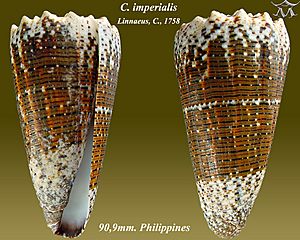Conus imperialis facts for kids
Quick facts for kids Conus imperialis |
|
|---|---|
| Five views of an imperial cone shell | |
| Conservation status | |
| Scientific classification | |
| Synonyms | |
|
The imperial cone (scientific name: Conus imperialis) is a type of sea snail. It is a marine gastropod mollusk, which means it's an animal with a soft body, often protected by a shell, that lives in the ocean. These snails belong to the family Conidae, also known as the cone snails.
Like all cone snails, the imperial cone is a predator and venomous. This means they hunt other small sea creatures and can deliver a sting. Their sting can be painful to humans, so it's very important not to touch them if you see one alive.
Contents
Different Types of Imperial Cones
There are a few recognized types of the imperial cone:
- Conus imperialis imperialis Linnaeus, 1758
- Conus imperialis queketti E. A. Smith, 1906
Discovering the Imperial Cone Shell
The shell of an adult imperial cone can range in size. It is usually between 40 mm (about 1.5 inches) and 110 mm (about 4.3 inches) long.
Shell Colors and Patterns
The shell is quite thick and has a yellowish-white or cream color. It often has many broken lines and spots of dark brown. You might also see two wider, irregular bands of light brown. Sometimes, the light brown color spreads out in cloudy, uneven patches. This can make it hard to see the distinct bands.
Shell Shape and Features
The shell has a flat top part, called a spire. This spire also has small bumps, or nodules, on it. The "shoulders" of the shell, where the spire meets the main body, are also nodular.
Where Do Imperial Cones Live?
You can find the imperial cone in warm ocean waters. They live in the Indian Ocean near places like Aldabra, Madagascar, the Mascarene Basin, and Mauritius.
They are also found all across the Pacific Ocean. In Australia, they live off the Northern Territory, Queensland, and Western Australia.
Gallery
Below are several color forms of the imperial cone:








